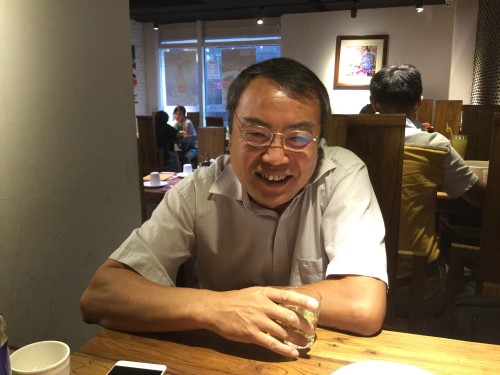Tag archives: cosmic rays
How to use a mountain to detect neutrinos

Aiming high: Zhen Cao explains how to use a mountain to detect tau neutrinos.
By Hamish Johnston in Beijing
This evening I had dinner with Zhen Cao, who is one of China’s leading particle astrophysicists and works at the Institute of High Energy Physics of the Chinese Academy of Sciences here in Beijing.
Cao has found a great way to combine his passion for mountains and neutrinos: the Cosmic Ray Tau Neutrino Telescope (CRTNT), which, if built, will use an entire mountain in western China as a cosmic neutrino detector.
View all posts by this author | View this author's profile
Cosmic rays, diamond anvils and spintronics in Utah

A blooming marvellous afternoon at the University of Utah.
By Hamish Johnston in Salt Lake City
Yesterday afternoon I hopped on a tram bound for the University of Utah. As you can see in the above photo, spring has sprung in Salt Lake City and the campus was resplendent in blossoms with views over snow-capped mountains.
I was at the university to film several 100 Second Science videos with Utah physicists including Shanti Deemyad, who studies the properties of matter under extremely high pressures. She is particularly interested in understanding the quantum properties of solids at temperatures near absolute zero – properties that can be enhanced when materials such as lithium are squeezed at pressures that are more than 10 million times greater than Earth’s atmosphere. This is done using a diamond anvil and Deemyad’s lab has 20 or so of them.
View all posts by this author | View this author's profile
Playing the cosmic piano
By James Dacey
Researchers at CERN are renowned for their musical side-projects. Notable examples include the album released by scientists at the ATLAS detector in 2010, and the “Large hadron rap“, which currently has almost 8 million hits on YouTube. And of course don’t forget the pop-star-turned-physicist Brian Cox who had the UK chart-topping hit “Things can only get better” in the 1990s with his band D:Ream.
Following in this musical tradition, a duo of Mexican researchers has invented a “Cosmic Piano” inspired by the technologies used at the ALICE particle detector at the Large Hadron Collider (LHC). The instrument’s inventors Arturo Fernández Téllez and Guillermo Tejeda Muñoz hold positions at CERN and the University of Puebla in Mexico. They hope the device can demonstrate both the science and the art of the work being carried out at particle-physics facilities.
View all posts by this author | View this author's profile